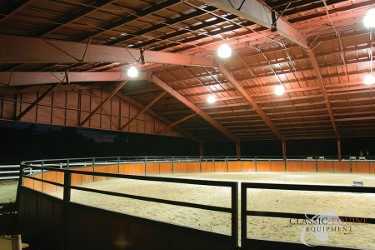A round pen or arena may be one of the best investments you ever make for your horses. It can serve as a useful training space, a safe place to turn out horses, and provides a smaller space to work a horse from the ground as well as in the saddle. Indoor arenas also protects riders and horses from the cold, snow, rain and wind in the winter and can also keep everyone cooler by providing shade in the summer.

The most common round pen size is 60 feet in diameter, but yours could be anywhere from 40 to 120 feet in diameter. Arena sizes depend on what you need them for and can run from standard size (100 x 200 feet) to driving arena size (130 x 330 feet) to competition jumping size (660 x 660 feet). When selecting your arena or round pen size, think to the future. You may be interested in dressage and feel you only need something 66 x 132 feet, but when perhaps in the future you may want to try jumping or may even be selling your facility to a hunter/jumper person. What suited you at the time may become a tough selling point to someone who needs more space. As with everything else in your barn, bigger is always better. Whatever your dimension, if you are planning on enclosing it with a fence, leave a little extra room around the perimeter.
Before you begin any work on your arena or round pen, objectively look at your proposed site. Know what type of soil you have. Different types of soils may determine the type and depth of base you will need as well as the type of footing. Brad Price of Earthbound Systems, Inc., recommends digging a 4 foot deep hole in your proposed site to get the best idea of what sort of soil you have. “While your soil may appear to be sandy on top, it may actually be heavy clay only a few inches down and that will affect your drainage no matter what type of footing you use.” Your riding surface should be level enough for riding, but with enough slope for water to run off. Check for any potential drainage issues and/or locate a nearby water source if you anticipate having to water your arena.
One of the most important aspects of good arena footing is the part you rarely see – the foundation. This is not the place to cut corners on either time of materials. According to the U.S. Dressage Federations arena and footing guide, “Under Foot,” your arena foundation ideally should consist of a sub-base (most often the existing soil of the site) and a base (usually made of crushed and compacted stone to produce a solid, non-shifting and non-slippery surface). The depth of the base is usually determined on how the arena will be used – remember your design plan? A dressage arena may not have as deep a base as one used for jumping or for heavy use. The use of geotextiles, a type of synthetic material available in different thicknesses, is an excellent addition when building your arena. It goes between the sub-base and the base and improves drainage, prevents soil or rocks from your sub-base from moving up and mixing with your base, and generally protects the sub-base during construction of the base.
When selecting the footing surface for the top level of the arena think again how the arena will be used. Is it indoor or outdoor? Will it have the heavy use of a training barn or are installing it in a small, private facility? Do you need the traction and cushioning for jumpers or the firm support for dressage horses? If possible, “test drive” different types of footing – what feels best to you and your horse when you ride on it? There are endless combinations of footing and many new products on the market. There are many other options for arena footing and all of them have pros and cons depending on your discipline, ease of maintenance, whether for indoor or outdoor use, and cost. While you can create an arena with just a base and the riding surface or even with just adding footing alone if finances are an issue, you may end up saving money on the arena only to pay vet bills later from leg injuries. Be sure to purchase your arena footing from a knowledgeable and reputable company. It is best to purchase less footing material than you think you’ll need. It’s easy enough to add more product, but almost impossible to take out footing if it’s too deep.
To keep fencing costs down, consider using modular panel options that are made of high-quality, heavy-duty materials and manufacturing components. There are often available in a multitude of dimensions. Check out our website for more information www.classic-equine.com

.jpg?width=90&name=email%20(1).jpg)

.jpg?width=119&name=arrow%20(6).jpg)
